Alien Atmospheres
NASA's Hubble Space Telescope has detected the atmosphere of a planet
circling a distant Sun-like star.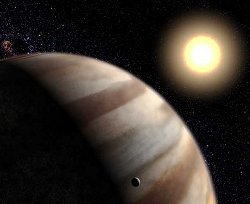
November 27, 2001: Astronomers using the orbiting Hubble Space
Telescope have made the first direct detection and chemical analysis of
the atmosphere of a planet outside our solar system. Their unique
observations show it is possible to measure the chemical makeup of
extra-solar planetary atmospheres -- and potentially to search for
chemical markers of life far beyond Earth.
Right:
An artist's impression of a gas-giant planet orbiting the yellow Sun-like
star HD 209458. Credit: G. Bacon, STScI.
The Jupiter-sized planet orbits a yellow, Sun-like star called HD
209458 that lies 150 light-years away in the constellation Pegasus. Its
atmospheric composition was probed when the planet passed in front of its
parent star, allowing astronomers for the first time ever to see light
from the star filtered through the planet's atmosphere.
"This opens up an exciting new phase of extra-solar planet
exploration," says Caltech's David Charbonneau. "[Now] we can
begin to compare and contrast the atmospheres of planets around other
stars."
It was Charbonneau, along with Timothy Brown (NCAR) and colleagues, who
used Hubble's "STIS" spectrometer to detect the presence of
sodium in the planet's atmosphere. The astronomers actually saw less
sodium than expected for this Jupiter-class planet, leading to one
interpretation that high-altitude clouds in the alien atmosphere might
have blocked some of the light.
The Hubble observation was not tuned to look for gases that would
likely appear in a life-sustaining atmosphere -- which were improbable
anyway for a planet as hot as this one. Nevertheless, this unique
observing technique opens a new phase in the exploration of extra-solar
planets, say astronomers. Such observations could potentially provide the
first direct evidence for life beyond Earth by measuring unusual
abundances of atmospheric gases caused by the presence of living
organisms.
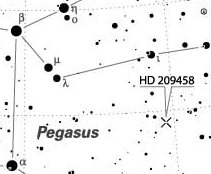 Left:
HD 209458 is a 7th magnitude star in the constellation Pegasus, visible
through binoculars or amateur telescopes. The planet itself is invisible
but the star is easy to find in Northern skies after sunset. Sky charts: northern
star map; detailed
map of Pegasus. Left:
HD 209458 is a 7th magnitude star in the constellation Pegasus, visible
through binoculars or amateur telescopes. The planet itself is invisible
but the star is easy to find in Northern skies after sunset. Sky charts: northern
star map; detailed
map of Pegasus.
The planet was discovered in 1999 as a result of its slight
gravitational tug on the star. It is estimated to be about 70 percent the
mass of the giant planet Jupiter, or 220 times more massive than Earth.
Subsequently, astronomers found that the tilt of the planet's orbit
makes it pass in front of the star, as seen from Earth. It that way it is
unique among all the extra-solar planets discovered to date (there are
approximately 80 of them). As the planet passes in front of the star, it
causes the star to dim very slightly for the duration of the transit.
Transit observations by Hubble and ground-based telescopes confirmed that
the planet is primarily gaseous, rather than liquid or solid, meaning that
it is a gas giant, like Jupiter and Saturn.
The planet is an ideal target for repeat observations because it
transits the star every 3.5 days -- which is the extremely short time it
takes the planet to go around the star at a distance of merely four
million miles (6.4 million km) from the stellar surface. This close
proximity heats the planet's atmosphere to a torrid 2,000 degrees
Fahrenheit (1,100 degrees Celsius).
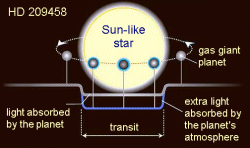 Astronomers
call such planets "hot Jupiters." They are more or less the size
of Jupiter but orbit closer to their stars than the tiny innermost planet
Mercury in our solar system. While Mercury is a scorched airless rock, hot
Jupiters have enough gravity to hold onto their atmospheres, though some
are hot enough to melt copper. Astronomers
call such planets "hot Jupiters." They are more or less the size
of Jupiter but orbit closer to their stars than the tiny innermost planet
Mercury in our solar system. While Mercury is a scorched airless rock, hot
Jupiters have enough gravity to hold onto their atmospheres, though some
are hot enough to melt copper.
Using Hubble, astronomers observed four separate transits of the planet
across HD 209458, searching for direct evidence of an atmosphere. And they
found it!
Above:
As seen from Earth, a gas giant planet passes in front of the Sun-like
star HD 209458 every 3.5 Earth days -- and absorbs a fraction of the light
from the parent star.
During each transit a small fraction of the star's light on its way to
Earth passed though the planet's atmosphere -- and was absorbed. When the
color of the light was analyzed, the telltale "fingerprint" of
sodium was detected. Though the star also has sodium in its outer layers,
STIS precisely measured the added influence of sodium in the planet's
atmosphere.
The team, which included Robert Noyes of the Harvard-Smithsonian Center
for Astrophysics and Ronald Gilliland of the Space Telescope Science
Institute, plans to look at HD 209458 again with Hubble in other colors of
the star's spectrum to see which are filtered by the planet's atmosphere.
They hope eventually to detect methane, water vapor, potassium and other
chemicals.

Above:
Sodium in the atmosphere of the planet filters out light from its parent
star. Image Credit: A. Feild, STScI.
Once other transiting giant planets are found in the next few years
(it's just a matter of time, say researchers) the team expects to
characterize their chemical differences. Just imagine, comparative
planetology -- outside the solar system!
Not long ago astronomers couldn't be certain that extra-solar planets
existed at all. Now they're being found at a rapid pace and, thanks to
Hubble, we can begin to study their properties. This is truly an exciting
moment in astronomy. And what's next? Only time -- and more observations
-- will tell.
What Lurks in the Outer Solar System?
It's just a matter of time, say researchers, before astronomers find something as big as
Pluto in the chilly outer reaches of the solar system.
September 13, 2001: Billions of kilometers from Earth, beyond the orbit
of Neptune, lies perhaps the most forbidding part of our solar system, a vast realm so
cold and dark it sparks a frisson of dread among thoughtful astronauts. The Sun, so
cheerful and warming here on Earth, is merely the brightest star in the night sky there.
And it's so cold that the atmosphere of Pluto -- the only one of the nine planets orbiting
so far from the Sun -- lies frozen on the ground most of the time. A spaceship exploring
the outer reaches of our solar system could go a long time without seeing much. And,
indeed, for most of the past century astronomers figured there was little enough to see:
only one small icy planet, Pluto, and its oddball moon Charon. Better perhaps to pass them
by and head for a far-away star.

Above: An artist's visualization of the
outer solar system. Reproduced courtesy of Dave Jewitt. But wait! Maybe the outer solar
system isn't so dull after all. Lately astronomers have found that the frontier beyond
Neptune, far from empty, is swarming with thousands of dark and mysterious objects --
enough to make a star-bound explorer pause for a second look.
As seen from Earth those dim companions of Pluto appear to dark comets. It's hard to know
exactly what they're made of because their insides are concealed by a layer of ruddy
organic goop. Probably they're a mixture of ice, rock, and dust. Most are about the size
of small asteroids (a few km to a few hundred km wide), and a few have emerged recently
that are 30% to 50% as wide as the planet Pluto (2274 km). Indeed, say astronomers, it may
be only a matter of time before observers spot one as
big as Pluto itself.
The first of these strange bodies, which astronomers call Kuiper Belt Objects (KBOs), came
to light in 1992, discovered by Dave Jewitt and Jane Luu -- a pair of scientists who
didn't believe the outer solar system was empty. Beginning in 1987 they had doggedly
scanned the heavens in search of dim objects beyond Neptune. It took five years, looking
off-and-on through the University of Hawaii's 2.2 m telescope, but they finally found what
they were after: a reddish-colored speck 44 AU from the Sun -- even more distant than
Pluto! Jewitt (University of Hawaii) and Luu (UC Berkeley) wanted to name their find
"Smiley," but it has since been cataloged as "1992 QB1."
Below: A 1992 discovery image of 1992 QB1
(indicated by the arrow) captured by Jewitt and Luu using the University of Hawaii's 2.2 m
telescope on Mauna Kea. The bright streak in this CCD image is an asteroid, faster-moving
that 1992 QB1 because it lies much closer to the Sun.

That discovery marked our first glimpse of the long-sought Kuiper Belt,
named after Gerard Kuiper who, in 1951, proposed that a belt of icy bodies might lay
beyond Neptune. It was the only way, he figured, to solve a baffling mystery about comets:
Some comets loop through the solar system on periodic orbits of a half-dozen years or so.
They encounter the Sun so often that they quickly evaporate -- vanishing in only a few
hundred thousand years. Astronomers call them "short-period comets," although
"short-lived" is more to the point. Short-period comets evaporate so quickly
compared to the age of the solar system that we shouldn't see any, yet astronomers
routinely track dozens of them. It was a real puzzle.
Kuiper's solution was a population of dark comets circlingthe Sun in the realm of Pluto --
leftovers from the dawn of our solar system when planetesimals were coalescing to make
planets. The ones beyond Neptune, Kuiper speculated, never stuck together, remaining
instead primitive and individual. Nowadays they occasionally fall toward the Sun and
become short-period comets.
Below: Planetesimals -- the building-blocks of planets --
were plentiful during the early days of our solar system. Are they still lurking unseen
beyond the orbits of Neptune and Pluto? This painting of the early solar system appears
courtesy of scientist and artist William K. Hartmann (copyright 2001, all rights reserved).
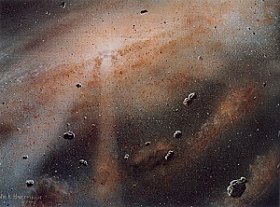
It was a neat solution to the mystery, but with the arguable exception of
Pluto, no one could find any members of the Kuiper Belt -- that is, until Jewitt and Luu
did it in 1992. Since then astronomers have been discovering KBOs at a dizzying pace. The
International Astronomical Union now catalogues 432 of them. And that's just the tip of
the iceberg. "Based on our surveys we think there are about 70,000
KBOs larger than 100 km across between 30 and 50 AU from the Sun," says Jewitt. If
you added all of them together they would form a planet about one-tenth the mass of Earth.
The Kuiper Belt is about 300 times more massive than the asteroid belt between Mars and
Jupiter, he added. Finding even 400 or so KBOs among the tens of thousands beyond Neptune
is impressive. These faraway objects are surprisingly dark. Although they're icy, explains
Jewitt, "most KBOs reflect about as much sunlight (4 - 7%) as a lump of
charcoal." It's because of cosmic ray bombardment, which darkens and reddens their
surfaces by breaking the bonds of molecules in the ice -- molecules that reform as complex
carbon-based compounds. The organic goop makes good camouflage against the black of space.
Below: High energy
cosmic rays blacken a comet's nucleus, which consists of a mixture of ices (yellow) and
rocks (red). The penetration depth of the cosmic rays into the ice could be as large as
one meter. The time difference T3-T0 is approximately hundred million years.

The planet Pluto, itself perhaps a KBO, is an exception. "Pluto has a
higher reflectivity (60%) than we suspect for other Kuiper Belt Objects," adds
Jewitt. "But this is an artifact of size. Pluto has enough mass and gravity to retain
a tenuous atmosphere from which bright surface frosts may be deposited
on the surface."
Are there more Plutos out there, yet to be discovered? Jewitt thinks so. "We have
known the size distribution of KBOs for some years," he says. "It's a power law
with index -4, and it suggests that a few Pluto-sized objects exist, perhaps 5 or 10, of
which we know just one." Relatively large KBOs are already turning up among the many
new discoveries. For example, last year Jewitt and colleagues
found Varuna orbiting 43 AU from the Sun. Varuna is 900 km wide and nearly as large as the
behemoth asteroid Ceres (933 km). Then came 2001 KX76, a discovery of the NASA-funded Deep
Ecliptic Survey. 2001 KX76 was a sensation for a while last month when widespread reports
credited it with dethroning Ceres as the solar system's largest asteroid. In fact, 2001
KX76, which is icy and
lies 39 AU from the Sun, is not an asteroid at all. But no matter, 2001 KX76 is still big,
perhaps 1200 or more km across.

Above: The relative estimated sizes of
Pluto, Charon, and eight large Kuiper Belt Objects in Sept. 2001. Only the diameters of
Pluto, Charon, and Varuna have been very accurately measured.
Lately the technology for finding KBOs, both big and small, has become a lot more
powerful. "Our CCD cameras are bigger and better, improving the efficiency of
detection," says Jewitt, whose recent work is supported in part by a NASA Origins
grant. "For example, we've been using a camera that has 24 times the area of the one
we used to find the first KBO in 1992. It pulls in 24 objects for the price of one."
Perhaps soon one of those CCDs will record a real sensation: the next Pluto. "It
could happen at any time," says Jewitt. After all, if we've learned anything in the
past 10 years, it's that the outer solar system is not only dark, remote, and cold, but
full of surprises as well.
Bizarre Boiling
Watching liquids boil in low gravity is an out-of-this-world experience. It
has plenty of entertainment value, but it's teaching scientists some important physics
lessons, too.
September 7, 2001: The next time you're watching a pot of water boil,
perhaps for coffee or a cup of soup, pause for a moment and consider: what would this look
like in space? Would the turbulent bubbles rise or fall? And how big would they be? Would
the liquid stay in the pan at all? Until a few years ago, nobody knew. Indeed, physicists
have trouble understanding the complex behavior of boiling fluids here on Earth. Perhaps
boiling in space would prove even more baffling.... It's an important question because
boiling happens not only in coffee pots, but also in power plants and spacecraft cooling
systems. Engineers need to know how boiling works.

Above: Without buoyancy or convection, boiling fluids
behave quite differently in space. Click on the image for a movie comparing boiling
in space and on Earth. Image courtesy NASA Glenn Research Center .
In the early 1990's a team of scientists and engineers from the University of Michigan and
NASA decided to find out. Using a freon coolant as their liquid, they conducted a series
of boiling experiments on the space shuttle during 5 missions between 1992 to 1996.
And indeed, they found some intriguing differences between what happens to boiling fluids
on Earth and what happens to them in orbit. For example, a liquid boiling in
weightlessness produces -- not thousands of effervescing bubbles -- but one giant
undulating bubble that swallows up smaller ones!
Now anyone can watch the fascinating behavior of boiling in weightlessness, thanks to a
video of footage from the experiments recently made available by NASA. (Information on how
to request
a copy is below.) "Think of it: no one had really seen boiling in space before these
experiments -- in the whole world, ever!" says Dr. Francis Chiaramonte, who was the
NASA Project Scientist for the
Pool Boiling Experiment. Already, he says, the series of experiments has come to be
regarded as "classic" by today's researchers. Despite its entertainment value,
this research is much more than
a simple curiosity. Learning how liquids boil in space will lead to more efficient cooling
systems for spacecraft, such as the ammonia-based system on the International Space
Station. Knowledge of boiling in space might also be used someday to design power plants
for space stations that use sunlight to boil a liquid to create vapor, which would then
turn a turbine to produce electricity.
The research could also have applications here on Earth. The weightless environment gives
scientists a new "window" into the phenomenon of boiling. Scientists can use
this perspective to improve their understanding of the fundamentals of boiling, which
might be used to improve the design of terrestrial power plants.

Above: The International Space Station uses a
"2-phase" cooling system in which ammonia changes from liquid to vapor and back,
which involves boiling. Engineers designing the ISS cooling system used information
gleaned from microgravity boiling experiments. "The phenomenon of boiling is so
complex that most of our understanding is empirical, rather than based on the
solutions to fundamental equations," Chiaramonte says.
In the free-fall of orbit, boiling is simpler than it is on Earth. Weightlessness
effectively removes two of the variables in boiling -- convection and buoyancy. This
difference explains why boiling liquids behave so differently in space. It also provides a
powerful tool for scientists who want to unravel the tangled physics of boiling. "As
an example, imagine you were trying to study the Earth, which has such complex ecosystems.
You would also want to look at a simpler planet with fewer variables. One thing space does
for us is simplify the problem that we're studying," Chiaramonte says.
When a pool of liquid is heated on Earth, gravity causes hotter regions in the liquid to
rise, and cooler, more dense parts to sink -- a process called "convection."
This motion spreads the heat around inside the liquid. Once it begins to boil, buoyancy
sends bubbles hurling upward, creating a "rolling boil." All of this motion
within the liquid makes the physics of the situation much more complex.

Above: Without buoyancy, the vapor produced by boiling
simply floats as a bubble inside the liquid after the heating has stopped. Surface tension
effects cause the many small bubbles produced to coalesce into one large sphere. Click the
image to see a 1.3 MB MPEG movie of smaller bubbles gathering into the large one.
Without convection or buoyancy, the process unfolds differently. Heated fluid doesn't
rise, and instead just sits next to the heater surface and continues to get warmer.
Regions of liquid away from the heater remain relatively cool. Because a smaller volume of
water is being heated, it comes to a boil much more quickly. As bubbles of vapor form,
though, they don't shoot to the surface -- they coalesce into a giant bubble that wobbles
around within the liquid. Much of this could be predicted from existing theory, but to
learn the fine details of the process and to look for unexpected
behaviors, a real experiment was necessary. "There were many fundamental issues that
were still not
understood well," says Dr. Herman Merte, the Principal Investigator for the
experiments. Merte, who some see as a kind of "founding father" of microgravity
pool boiling research, devised the experiments featured in the video tape.
Merte and other scientists had performed earlier research on weightless boiling using
"drop towers," which could simulate zero-G for a few seconds by simply dropping
samples inside a tall tower. These early experiments provided some guidance for designing
the shuttle-based experiment, but these brief glimpses don't really compare to the
minutes-long observation provided by the shuttle.
One important product of that early research, though, was a method for building a boiling
chamber that let scientists look through the heater surface and watch the liquid right
where it contacts
the heater. "The action is right at the solid-liquid interface at the heater, and you
can't look down from the top because you have the refraction of the fluid's upper surface
that interferes," says Merte, who recently retired as Emeritus Professor of
Mechanical Engineering at the University of Michigan.
Merte used quartz to make a smooth, hard, transparent bottom for the boiling chamber. Then
he coated that quartz with an ultra-thin layer of gold. Less than 400 angstroms thick (an
angstrom is one ten-billionth of a meter), this layer was so thin that it allowed visible
light to pass through it, yet it still conducted electricity like bulk gold.

Above: One way to simulate the weightlessness of
space is to simply let an experiment freefall inside a "drop tower," such as
this one at NASA's Glenn Research Center in Cleveland, Ohio. Other methods for simulating
weightlessness include flying parabolic arcs in aircraft -- such as NASA's KC-135
"vomit comet" used to train astronauts -- and using sounding rockets. Image
courtesy NASA Glenn Research Center.
Using this apparatus, Merte and his colleagues made some interesting discoveries. For
example, depending on the temperature conditions of the experiment, the giant bubble would
sometimes float in the center of the liquid and sometime remained attached to the heater
surface. When the bubble remained attached -- which Merte calls a "dry out" --
it effectively insulated the liquid from the heater, preventing further boiling and
causing the heater temperature to soar. Knowing precisely the conditions when this occurs
is vital for designing spacecraft systems that might rely on boiling.
"If you understand a phenomenon better, then you can design for it closer to its
limits for optimization," Merte says. "If you have an uncertainty, then you're
going to design conservatively."
Today's researchers continue to expand on the foundation of knowledge laid by these
experiments. With a better understanding of the physics of boiling fluids, engineers will
be able to design
improved cooling and power systems to serve people in the future -- both in space and here
on Earth.
Black Hole Snacks
NASA's Chandra X-ray Observatory has spotted a curious outburst from our galaxy's core --
a sign that the Milky Way's central black hole may be snacking on its neighbors.
Sept. 5, 2001: Astronomers have long suspected that the Milky Way harbors
a "monster in the middle" -- that is, a supermassive black hole at the very
center of our pinwheel galaxy. Other galaxies
have one, they reasoned, so ours probably does, too. But finding it hasn't been easy.
Light (by definition) can't escape a black hole, so the Milky Way's central monster has
remained elusive.
Right: An artist's concept of matter swirling, like water down the drain of a bathtub,
into a supermassive black hole. Courtesy of the Chandra X-ray Observatory's X-ray
Astronomy Field Guide.
Undaunted, observers have been peering into the heart of the Milky Way for many years. The
fast motions of stars and gas around the galactic center suggested that something very
massive indeed
was hidden there. But what? If it was a black hole, X-ray telescopes ought to detect a
telltale glow from super-heated gas swirling into the hole -- what astronomers call an
"accretion disk." Astronomers had spotted such X-ray emitting disks at the
hearts of other galaxies, but not inside the Milky Way. It was a real puzzle.
So, when NASA launched the Chandra X-ray Observatory a little more than two years ago, a
team of astronomers led by MIT's Fred Baganoff wasted no time turning the sensitive
telescope
toward the galactic center. And in September, 1999, they found what they were looking for:
faint X-ray emissions from fiery gas circling a black hole. The monster, massing nearly
three million times more than our own Sun, was real. Now, they may have caught the black
hole in the act of devouring something, too.
On October 26, 2000, Baganoff and colleagues were once again using Chandra to monitor the
center of our galaxy when they recorded a powerful X-ray outburst. They were looking
toward "Sagittarius A*," an intense radio source that astronomers believe is
powered by the black hole. During a span of just a few minutes, X-ray emissions from
Sagittarius A* became 45 times brighter
than normal, before declining to pre-flare levels a few hours later. "This is
extremely exciting because it's the first time we have seen our own neighborhood
supermassive black hole devour a chunk of material," said Baganoff. "It's as if
the material there sent us a postcard just before it fell in." The energy released in
the flare corresponds to a sudden infall of material with about as much mass as a comet or
an asteroid. The black hole literally gobbled something up! On the other hand, say
scientists, the flare might have been caused by the reconnection of magnetic field lines
near the black hole -- a process that also triggers solar flares on the Sun.

Above: This false-color image shows the
central region of our Milky Way Galaxy as seen by Chandra. The bright, point-like source
at the center of the image was produced by a huge X-ray flare that occurred in the
vicinity of the supermassive black hole at the center of our galaxy. Credit: NASA/MIT/F.
Baganoff et al.
In either case, shock waves from the explosion would have accelerated electrons near the
black hole to nearly the speed of light -- leading to the observed outburst of X-rays. A
longer-term increase in radio emission was also recorded beginning around the time of the
flare, indicating that, indeed, the production of high-energy electrons was increasing.
At the peak of the flare, the X-ray intensity dramatically dropped by a factor of five,
then recovered, all within a 10-minute interval. Such fluctuations constrain the size of
the emitting region to be no larger than about 20 times the size of the event horizon --
the one-way membrane around a black hole predicted by Einstein's theory of relativity.
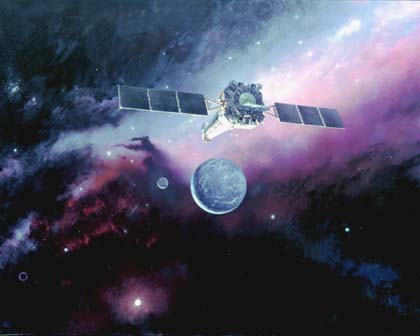
Below: An artist's illustration of the orbiting Chandra
X-Ray Observatory. Credit: TRW. "The
rapid variations in X-ray intensity indicate that we are observing material that is as
close to the black hole as the Earth is to the Sun," said Gordon Garmire of Penn
State University, principal investigator of Chandra's Advanced CCD Imaging Spectrometer,
which was used in these observations.
"This signal comes from closer to the event horizon of our galaxy's supermassive
black hole than any that we have ever received before," agreed Baganoff. Indeed,
X-ray observations of Sagittarius A* seem to offer a unique way to probe activity very
close to such black holes where space and time itself are twisted.It's a prospect
that thrills astronomers who have been waiting a long time for such data. Consider that
the first discussions of black holes -- by the French physicist Pierre Laplace and the
English philosopher John Michell -- date back to the 18th century. But until recently we
couldn't even find the biggest one in our own galaxy! Thanks to Chandra's sensitive X-ray
cameras, however, black holes are finally revealing their secrets, a well-earned reward
for patient astronomers.
Wide Awake in Outer Space
Space travel can be exciting -- and restless! NASA researchers are exploring ways to help
astronauts enjoy a better night's sleep on the space station ... and beyond.
Sept.4, 2001: Astronauts sleep poorly in space, and it's
no wonder.Just consider: the excitement of blasting off on a powerful rocket, the strange
sensations of floating in free-fall, the novelty of mornings that return every 90
minutes... Who could sleep
through all that?
On some space shuttle missions up to 50% of the crew take sleeping pills, and, over all,
nearly half of all medication used in orbit is intended to help astronauts sleep. Even so,
space travelers average about 2 hours sleep less each night in space than they do on the
ground.

Above: In low-Earth orbit the Sun rises
and sets every 90 minutes, which can be a sleep-scrambling experience for astronauts. The
crew of shuttle mission STS-47 captured this picture of a dramatic sunrise -- one of many
they enjoyed during their week-long mission.
That deficit adds up, says Dr. Ken Wright, Instructor in Medicine at Harvard Medical
School, and Associate Neuroscientist at Brigham and Women's Hospital. "Research
performed on Earth suggests that some of them, after a week or two on this restricted
sleep schedule, are performing at the level of someone who's been awake for 24-plus
hours.”
Fatigue, on Earth or in space, is a serious problem. It affects performance, increasing
irritability, diminishing concentration, and decreasing reaction time. And it increases
the risk of accidents. On Earth, sleep can be disrupted by anything from a crying
baby to tomorrow's exam. In space wakefulness can come from noise and excitement -- and,
possibly, the disruption of the circadian rhythms that ensure a good night's sleep.
Sleep is, in large part, managed by our body's master clock, which is located in the
brain's hypothalamus. This clock regulates the body's daily production of melatonin, a
sleep-promoting hormone, and cortisol, a hormone that promotes wakefulness, and is also
associated with stress. The clock also manages a multitude of other physiological cycles,
including body temperature, growth hormone production, heart rate, and urine production.
The circadian clock generates these cycles all on its own. But there's a problem.
Free-running, the master clock produces cycles that average about 24.2 hours -- slightly
longer than Earth's day. So the clock must be reset. It needs to be adjusted daily to
ensure that the biological day and night don't get out of sync with the environment. On
Earth, it's reset automatically, simply by our exposure to the high intensity light of
day.

Above: Motion restraints and a dark mask
help this floating astronaut fall asleep aboard the brightly-lit freely falling space
shuttle.
But in space, the right cue isn't so easily provided. The space shuttle orbits Earth every
90 minutes. So, instead of receiving the Terran pattern of 12 hours of light followed by
12 hours of dark, astronauts on the shuttle's flight deck experience 45 minutes of light
succeeded by 45 minutes of dark. This rapid-fire exposure might disrupt -- or as sleep
researchers say, "disentrain" -- the astronauts' circadian cycle. It's important
that the cycle be entrained: that the astronaut's biological day matches the environmental
one. "The circadian system is set so that you're best prepared to be alert and awake
during the biological day, and to sleep at [biological night],” says Wright. If the
body is required to perform activities at the wrong biological time, he explains, it will
not function optimally. For that reason NASA sometimes deliberately shifts the astronauts'
cycles before sending them into space, making sure that their biological day coincides
with the crucial period of launch, according to Dr. Bette Siegel, a scientist in the
Bioastronautics division at NASA headquarters. Effecting the shift is easy: astronauts are
exposed to high intensity light at key times for three to ten days before liftoff. By the
time the shuttle is ready to leave Earth, the crew is bright-eyed and alert. Once in orbit
the biological clocks of astronauts might need to be adjusted further to align with
another critical time -- the moment of landing. It's done by requiring the crew to wake up
earlier and earlier each day. Researchers still aren't sure exactly what happens to the
circadian clocks of astronauts under such circumstances.
To help find out, astronauts wear an actiwatch -- a wrist device that tracks astronaut
sleep patterns along with their light exposures. "We have models,” says Wright,
"where we can take their sleeping history and their light exposure history and
predict what's going to happen to their [internal] clock.” The actiwatch, along with
sleep diaries kept by the astronauts, will help researchers figure out which factors --
such as light exposure, temperature, or ambient noise in the close confines of a
spacecraft -- affect
sleep most during spaceflight.

Above: An "actiwatch," worn by
astronauts to document sleep patterns in space. Credit: Brigham and Women's Hospital,
Harvard Medical School, NASA Ames, and UC San Diego.
But even with this information, scientists still need to answer some basic questions in
order to develop countermeasures against unwanted wakefulness. For instance, what exactly
controls the master clock? What intensity of light will trigger it -- and which colors?
Does gravity itself provide a cue? All these questions will grow in importance as humans
move farther into space. Take the exploration of Mars, for example. On Mars, daylight is
primarily yellowish-brown. On Earth, it's blue-green. How will the human clock respond to
the unearthly color of Martian skies? Some research indicates that it could make a
difference. Melatonin production, for example, is suppressed more by some wavelengths of
light than by others.
Below: The unearthly color of Martian daylight could scramble the
circadian rhythms of human explorers. Artist Pat Rawlings painted this beautiful scene.

Of more concern, perhaps, is the length of the Martian day: 24 hours and
thirty-nine minutes. "That is significantly different than the period of the clock in
humans,”
notes Wright. It's possible, he says, that the human clock might not be able to adapt to
Mars. Ongoing research addresses this question by exploring countermeasures -- for
example, different patterns of light exposure -- that will entrain the human clock to a
longer day.
Learning to manage the circadian clock is critical to exploring space. But astronauts are
hardly the only ones with sleep problems. "The space environment," says Wright,
"provides us with a unique opportunity to understand something more about the
functions of sleep." Part of the research involves trying to understand ways to
promote wakefulness for shift workers, or people suffering jet lag, or simply for the many
people who don't get enough sleep. "It's an exciting topic,” says Wright,
"because it affects everyone.” Indeed, countermeasures that Wright and his
colleagues devise for astronauts in space might well provide a more restful night for
those of us remaining on Earth.
A New Comet
Last weekend an amateur astronomer peered through his telescope and found a new comet the
old-fashioned way --by looking.
August 24, 2001: In centuries past astronomers discovered new comets the
old-fashioned way: they peered through telescopes or simply looked toward the sky, hunting
for faint smudges that no one had seen before. It was hard work, but lots of people did
it. Comets are named after their discoverers, after all, and finding a new one can mean
instant fame. Hale-Bopp, Hayakutake and Shoemaker-Levy are just a few of the names we know
... because of comets.
But lately it seems just about every new comet is called "LINEAR" or
"NEAT." Those are names, too, but not the names of humans. They're robots --
automated, computer controlled telescopes
that scan the skies in a relentless search for near-Earth asteroids and comets. This year
between January and mid-August such telescopes recorded 18 new comets, while humans had
found none.
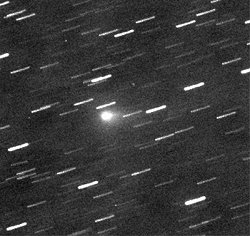
Above: Comet Petriew photographed on August 23rd by Tim
Puckett a using a 60 cm Ritchey-Chretien reflecting telescope equipped with an Apogee AP-7
CCD camera. Comet hunters -- the human kind -- just can't compete! At least that's how
many beleaguered sky watchers have been feeling.But last weekend an amateur proved
humans can still bag a comet and do it the old-fashioned way.
Vance Petriew of Regina, Saskatchewan -- a computer consultant by day and an amateur
astronomer by night -- was at the Saskatchewan Summer Star Party on August 18th when he
turned his 20" telescope toward the Crab Nebula. Hopping from one star to another
across the constellation Taurus, Petriew guided his telescope toward the famous supernova
remnant -- but he never made it.
He stopped instead at a curious smudge that appeared unexpectedly in his eyepiece. "I
almost passed it by because I was looking for the Crab Nebula," says Petriew,
"and this wasn't it." But there was something intriguing about the smudge,
something that made Petriew investigate further. "Thinking it might be a galaxy, I
looked at my star charts to see if any were nearby. Just then Richard Huziak (Saskatoon
Centre, Royal Astronomical Society of Canada) happened to walk over for the first time
that night." Huziak was familiar with the region of sky and knew that no eye-catching
galaxy was in the vicinity. The pair quickly realized that Petriew had stumbled onto an
unknown comet.
"It's like winning the lottery!" says Petriew. "Only [two people] in the
whole world discovered a comet last year the same way I did. It's pretty cool to have one
named after me and I'm very excited!"
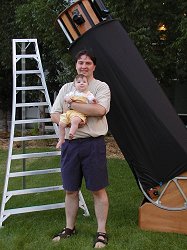
Right: Vance poses with his 8 month old daughter Emily and the 20" Obsession
telescope he used to spot the new comet.
Petriew announced his discovery hours later, and since then astronomers have been
monitoring the newfound comet to learn more about it. Based on data spanning less that a
week, it appears that Comet Petriew may be traveling around the Sun once every 5.5 years
following an elliptical path that stretches from a point just inside Earth's orbit (0.95
AU) out to the realm of the giant planet Jupiter (5.3 AU). Says Brian Marsden of the
Smithsonian Institution's Minor Planet Center: "We're still not completely sure of
the orbital period, but Comet Petriew might have passed close to Jupiter in 1982 -- an
encounter that could have nudged the comet into its current orbit." Before 1982 Comet
Petriew's orbit was probably bigger than it is now. It couldn't have come so close to
Earth in decades past, which might explain why it was never spotted before. Very long ago
-- perhaps hundreds of millions of years -- Comet Petriew inhabited the Kuiper Belt, a
doughnut-shaped cloud of dormant comets that circle the Sun beyond Neptune. Kuiper Belt
comets tugged by the gravity of giant planets in the outer solar system can be nudged
closer to the Sun, where they might eventually settle into orbits with periods of only a
few years. Comet Petriew appears to be one of these, a short period object that will
revisit the inner solar system frequently. At the moment Comet Petriew is near perihelion,
its closest approach to the Sun. Solar heat is vaporizing the comet's icy outer layers,
unleashing a cloud of gas and dust around the nucleus. That amorphous cloud, which
astronomers call the "coma," is what caught Petriew's attention when he swung
his telescope through Taurus last Saturday. Photos captured since then reveal a short
tail, not much bigger than the coma itself. Seen through modest telescopes Comet Petriew
has the look of a cosmic tadpole.

Above: Comet Petriew is slowly gliding
between the constellations Taurus and Gemini, which appear in the eastern sky before dawn.
This star chart shows where to look on August 26, 2001. Click to view orbital elements, to
calculate an ephemeris for the comet, or to manipulate the comet's 3D orbit.
No doubt plenty of astronomy enthusiasts will haul their telescopes
outdoors in the weeks ahead to peer at the new comet. And perhaps some of them will scan
the skies for comets of their own. It's worth a try. After all, Vance Petriew is living
proof that not every comet's name is LINEAR.
Having a Ball on Mars
An amusing accident in the Mojave desert has inspired a new kind of Mars rover -- a
two-story high beach
ball that can descend to the Martian surface, land safely, and explore vast stretches of
the Red Planet.
August 17, 2001 -- Researchers at the Jet Propulsion Laboratory (JPL)
have hit upon an idea for exploring the Red Planet that seems to be equal parts fun and
serious science: it's a lightweight,
two-story tall beach ball called "the tumbleweed rover." Equipped with
scientific instruments and propelled by nothing more than the thin Martian breeze, the
tumbleweed could potentially
explore vast tracts of planetary terrain. The wind blowing across the face of the Red
Planet would be the only engine needed to move such a ball from place to place, says Jack
Jones of JPL's Inflatable Rover Program.

Above: This is not your parent's Mars
rover! A giant inflatable ball -- bearing little resemblance to better-known rovers like
Sojourner -- might someday prowl the surface of the Red Planet. A 6-meter diameter ball on
Mars could accelerate to about 10 m/s (22.4 mph) pushed along by Martian afternoon winds
of 20 m/s (44.7 mph).
A payload carrying instruments such as cameras or a water-seeking radar could be held in
place by tension cords at the tumbleweed's center. When it's time to stop for a while,
perhaps to study an interesting spot or to wait for the wind to change direction, mission
controllers would simply command the ball to partially deflate. Then, when it's time to
move along again, the ball could be reinflated to roll on toward new frontiers. "This
is preliminary work," Jones cautions. But he is enthusiastic about the promise this
technology might hold for exploration of Mars and other
worlds with thin atmospheres such as Pluto, Neptune's moon Triton or Jupiter's moon Io.
For now, though, the focus is on Mars. Much of the Martian terrain is sloping and littered
with boulders, which makes tough going for most vehicles. But researchers were encouraged
by the results of tests this summer with a 1.5 meter-tall version of the tumbleweed. Their
experiments in the Mojave Desert confirmed that 6-meter diameter balls should be able to
climb over or around one-meter rocks and travel up slopes 25-degrees and higher in the
thin, but breezy Martian air.
View a video of the test narrated by Jack Jones Below: To a certain extent, a
"tumbleweed"
rover would be at the mercy of the whimsical wind, but it would have the ability to
"throw anchor" by partially deflating.
Follow the Bouncing Ball
Serendipity and a busted wheel on an experimental rover played a role in planting the idea
that would grow into the tumbleweed ball. Previous tests of beach ball-size tumbleweed
prototypes had
been disappointing. "They got stuck," Jones explained. Driven by the wind, the
toy-size balls lodged against knee- and waist-high rocks like those that litter Mars. As
rovers, the beach balls flopped.
But then, while conducting tests of an experimental inflatable rover in the Mojave
Desert's Dumont Dunes, one of the bright yellow rover's shoulder-high spherical
"tires" broke off the vehicle and blew away.
"It went a quarter of a mile in nothing flat," recalled technician Tim Connors,
who quickly saddled up with the driver of a passing all-terrain recreational vehicle to
chase down the runaway sphere.
The moderate, 20-mile per hour afternoon winds drove the ball fast and far.

Above: The spherically-wheeled rover that inadvertently
gave birth to the idea for a giant tumbleweed ball.
When one of the wheels broke loose during a test, it traveled across the terrain only too
well! "It soared," Jones said of the big ball. Watching Connors in hot pursuit,
the researchers marveled at the speed of the rogue sphere and the ease with which it moved
across the
desert, unimpeded by boulders. "Tim was flying over the sand dunes trying to catch
it," he said. "The ball went up steep, steep cliffs of sand. Nothing stopped
it." Until Connors, on the borrowed ATV, was able to catch up and corral the escapee.
"And therein was planted the seed," said Jones,
"that if we make these things big enough, nothing will stop one." Toys,
Balloons, and Serious Science In a lab that appears to mix serious R&D with the
ambiance of Santa's festive workshop, Jones and his colleagues are surrounded by shiny
Mylar balloons of various sizes, pink and yellow beach balls, heavy-duty nylon tumbleweed
ball prototypes, tall tanks of compressed gas and worktables full of mechanical and
electronic devices. The team, which includes senior engineer Sam Kim and design engineer
Jay Wu, is now preparing for desert tests later this month that will incorporate a radar
into the ball's center to test the prototype's ability to find underground water. Such
instrumentation could eventually be used to search for possible water hidden beneath Mars'
surface.
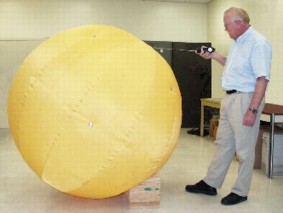
Above: Jack A. Jones with a 1/4-scale
prototype of a tumbleweed rover.
While more conventional rovers -- such as the Mars Pathfinder -- must somehow navigate
around large, meter-size boulders, a tumbleweed rover would simply roll right over them!
The ball is weighted so that it has a preferred axis of rotation. It tends to roll with
the heaviest part down, so two weights opposite each other send the ball along a straight
path. The upcoming tests will also try out a center-of-mass control device that would
allow the ball to be steered by pumping contained fluid to the left, right or center of
the tire, which will be slightly oblong. "Again, this is experimental, so we're
trying different
things," says Jones. "But I'm pretty confident it will work." "With a
20 kilogram ball and 20 kilogram payload, the 6-meter diameter tumbleweed ball is light
enough that it could be added on to another lander and deployed from the ground, or it
could be in its own delivery vehicle," he added. The
large, lightweight ball could possibly also serve as its own parachute and landing airbag
able to withstand the bounce following a 30-meter per second terminal velocity descent to
Mars. The
ball shares the same heritage as the airbag used for the 1996 Pathfinder mission.
Upcoming Tests
Other work being planned for coming months include desert drop tests with a prototype
tumbleweed ball made of super rugged Vectran, the same material used for the Mars
Pathfinder's airbag landing system. In the coming year, Jones hopes to arrange for
long-range testing of hundreds or thousands of kilometers in the harsh, challenging,
Mars-like environment of the Arctic or
Antarctic.
August 22, 2001: Three months ago when NASA's adventurous
Galileo spacecraft skimmed a mere 138 km above the surface of Jupiter's moon Callisto,
onboard cameras captured the sharpest pictures ever of that moon's mysterious landscape.
Scientists have since examined the images, and what they found is surprising. Callisto is
peppered with strange icy features -- spires that seem to be slowly eroding on a world
long considered changeless and dead. "We haven't seen terrain like this before. It
looks like erosion is going on, which is pretty surprising," said James Klemaszewski
(Academic Research Lab) who, along with David Williams and Ronald Greeley (Arizona State
University), is analyzing Galileo's latest pictures of Callisto.

Above: Bright scars on a darker surface testify to a long
history of impacts on Jupiter's moon Callisto in this image of Callisto from NASA's
Galileo spacecraft. The picture, taken in May 2001, is the only complete global color
image of Callisto obtained by Galileo.
Callisto's icy surface is the most heavily cratered place in the Solar System. There are
no volcanoes or winds and rain to obliterate landforms. So, craters that form as the
result of occasional impacts with meteorites are very long-lasting. Planetary scientists
call terrains like Callisto's "old." Earth's much-weathered surface, on the
other hand, is very "young." For billions of years, little has changed on
Callisto other than the relentless accumulation of craters -- or so researchers thought.
Galileo's latest images are painting a different picture. Callisto's knobby terrain is
unlike any seen before on Jupiter's moons --and it's not entirely unchanging. During the
Callisto flyby, Galileo's camera saw spire-like "knobs" jutting 80 to 100 meters
(260 to 330 feet) high, consisting perhaps of material thrown outward from a major impact
billions of years ago. The knobs are very icy, but they also harbor some darker dust. The
dark material seems to be sliding down the knobs and collecting in low-lying areas.
"They are continuing to erode and will eventually disappear,"
Klemaszewski said. One theory for an erosion process is that, as some of the ice turns
into vapor, it leaves behind dust that was bound in the ice. The accumulating dark
material could absorb enough heat from the distant Sun to warm the surrounding ice and
keep the process going.

Above: The top inset shows some of Callisto's many icy
knobs. The bottom image shows a dark-plained region where erosion has essentially ceased,
allowing impact craters to persist and accumulate.
The eroding spires of Callisto are just one of the moon's
riddles. Indeed, with a diameter of 4,800 km -- nearly the size of Mercury -- Callisto is
a bona fide world of its own with mysteries befitting a full-fledged planet. For example,
magnetic readings picked up by Galileo when it encountered Callisto in 1996 and 1997
suggest that the pock-marked satellite harbors one of the solar system's biggest salty
oceans. But the water, if it's really there, does not lie atop the frigid surface.
Instead, Callistan oceans would be hidden deep below the moon's spikey, slowly eroding
crust -- another tantalizing puzzle for future spacecraft and explorers.
The Biggest Explosions in the Solar System
NASA's HESSI spacecraft aims to unravel an explosive mystery: the
origin of solar flares.
June 12, 2001 -- Astronauts love space walks.
Floating weightless hundreds of kilometers above Earth, the terrain below racing by at
17,000 mph --no space traveler wants it to end. But it only takes two words to send one of
those brave explorers racing back to their craft: "Solar flare!"
"Solar flares are the biggest explosions in the solar system," says Robert Lin
of UC Berkeley's Space Science Lab. "They erupt near sunspots with the force of a
hundred million hydrogen bombs." Astronauts caught spacewalking during a solar flare
or one of their cousins, a coronal mass ejection, can absorb a radiation dose equivalent
to 100 chest x-rays -- reason enough to dash for shelter.

Above: Astronaut Steven Smith floats
above Earth during shuttle mission STS-103.
Flares pose little direct danger to Earth dwellers because our planet's atmosphere
protects us from their deadly radiation. But unpredictable solar explosions do affect our
lives. They can disable satellites, scramble aircraft navigation, and interrupt
high-frequency radio communications for hours.
"One of the most amazing things about solar flares," says Brian Dennis of NASA's
Goddard Space Flight Center, "is the efficient way they accelerate subatomic
particles to energies exceeding 109 eV." As much as 50% of the total explosion energy
emerges as electrons and atomic nuclei traveling at nearly the speed of light.
"Flares operate much more efficiently than any particle accelerator we've been able
to build here on Earth."
"How do flares do that?" he asks. We don't know, but terrestrial particle
physicists would love to find out.
What ignites solar flares? How do they unleash so much energy so quickly? And is it
possible to predict when they will happen?
Such questions have vexed astronomers since 1859 when Lord Carrington spotted a solar
flare for the first time. "I was [counting sunspots on a projected image of the
Sun]," he recalled, when suddenly "two patches of intensely bright and white
light broke out" near a remarkably large sunspot group. "Flurried by the
surprise," Carrington rushed from his telescope to call a second witness, but by the
time he returned minutes later the outburst had vanished.
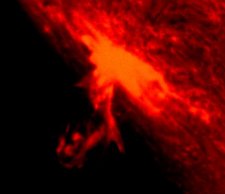
Above: A solar flare in action, blasting hot gas away from the limb of the Sun.
Carrington knew he had glimpsed something enormously powerful, but what he saw was just
the tip of the iceberg. Fast-moving particles that emerge from flares radiate mostly
high-energy x-rays and gamma-rays. Lower-energy visible light isn't as important.
And therein lies the reason that flares have been able to guard their secrets for so long.
The explosions are brightest at wavelengths that Earthbound observers can't see with their
eyes. Telescopes are hobbled, too, because our atmosphere is opaque to x-rays and
gamma-rays.
Now a new NASA satellite aims to change all that. The High Energy Solar Spectroscopic
Imager (HESSI for short) will orbit Earth nearly 600 km above our planet's obscuring
atmosphere, where it can record x-ray and gamma-ray emissions from flares. HESSI, which is
slated for launch no earlier than June 20th, isn't the first spacecraft capable of
detecting such radiation. But it will be the first to capture crisp hard x-ray and
gamma-ray images of the violent explosions.
"The angular resolution of HESSI's hard x-ray images will be about 2 arcseconds or
about as good as you could get from an optical telescope on the ground." says Lin,
the mission's principal investigator. The gamma-ray images will be a little less detailed,
with resolutions between 7 and 36 arcseconds. But, Lin notes enthusiastically, "we've
never seen any gamma-ray image of a solar flare before." HESSI's will be the first
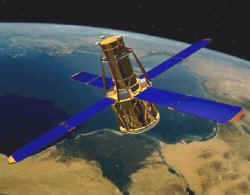
Above: An artist's rendering of HESSI in orbit 600 kilometers above Earth.
To put these numbers into perspective, consider the following: When a solar flare erupts,
it heats a region of the Sun's atmosphere many Earth-diameters across. (What Carrington
saw in 1859 was the white light "bloom" from such a flare.) HESSI's hard x-ray
images will reveal details only 1700 km wide -- about the distance between Los Angeles and
Seattle.
That's amazing because such high-energy x-rays and gamma-rays can't be focused; they fly
right through conventional lenses. Instead, HESSI forms images by looking at the Sun
through finely-spaced parallel slats --like microscopic Venetian blinds-- that cast
shadows across onboard radiation detectors. "We'll rotate the spacecraft every 4
seconds to create a modulation pattern from the shadows that we can analyze to form an
image of the Sun," explains Lin. The process is similar to a medical x-ray, except
scientists are interested in the source of the rays (the Sun), not the material that
blocks them (the slats).
HESSI's cameras can make pictures of the entire Sun, but researchers will be especially
interested in sunspots. "That's where flares erupt -- in the vicinity of sunspots
with intense, twisted magnetic fields," says George Fisher, a colleague of Lin's at
Berkeley. "Twisted magnetic fields are like rubber bands stretched taut," he
explained. "They want to snap back -- violently. Reconnecting fields are probably the
power source for flares."
At least that's what most solar physicists believe. The problem is, no one has ever seen
it happen. "Before HESSI we couldn't locate the onset of an eruption with sufficient
precision to make the connection between flares and kinks in the magnetic field,"
says Fisher. "I'm dying to know where flare particles are accelerated, and I think
HESSI is finally going to show us."
HESSI's job is important fundamental physics, adds NASA's mission scientist Brian Dennis.
Understanding how flares work could teach us how to build better particle accelerators on
Earth and maybe even advance the cause of fusion power, which also involves superheated
gases threaded by magnetic fields.
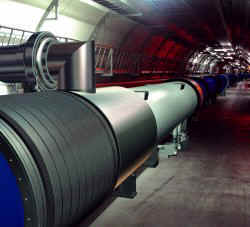
Above: Inside the CERN
high-energy particle accelerator in Geneva. Basic research on solar flares might one day
improve such devices on Earth. © CERN Geneva
HESSI's findings will also shed light on mysterious happenings far outside our solar
system. "Whatever triggers solar flares could be the same mechanism that blasts jets
of particles from the magnetized accretion disks of black holes and neutron stars,"
says Dennis. "The Sun is comparatively nearby, so it's a natural laboratory for
studying such exotic processes."
Meanwhile most astronauts would be satisfied with simple timely predictions of
garden-variety solar flares, a potential spinoff of the HESSI mission. If the spacecraft
can accomplish that one thing, space will become a safer place ... for everyone.
The Deep Space Network
NASA's traffic control system for interplanetary spacecraft is bracing
for a flurry of activity in deep space.
June 6, 2001 -- On April 28, 2001, a weak radio signal reached Earth from beyond
the orbit of Pluto. It was NASA's Pioneer 10 spacecraft, struggling to communicate with
ground controllers, its message riding on a radio signal that registered just a billionth
of a trillionth of a watt.
How do you listen to a transmission that couldn't make a lightbulb glow in
a billion years? It's all in a day's work for NASA's extraordinary Deep Space Network
(DSN).
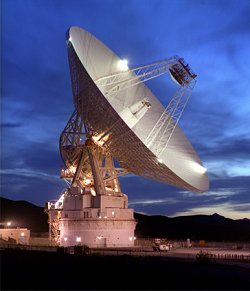
Above: A 70-meter antenna at the Deep Space Network Goldstone complex in California.
The DSN is a global system for communicating with interplanetary spacecraft. The
largest and most sensitive scientific telecommunications system in the world, it also
performs radio and radar astronomy observations for the exploration of the solar system
and the universe.
"Communicating with missions in deep space is difficult," said Joseph
Statman, Manager of the Deep Space Mission System Engineering Office at NASA's Jet
Propulsion Laboratory (JPL). "It requires extremely large antennas, huge transmitters
and very sensitive receivers."
The DSN consists of three clusters of antennas spaced approximately 120 degrees apart
around the world: at Goldstone, in California's Mojave Desert; near Madrid, Spain; and
near Canberra, Australia. "The strategy here is, no matter where the spacecraft is,
you're always in contact with it," explained Statman. Each complex is situated in
semi-mountainous, bowl-shaped terrain to shield against radio frequency interference.

Above: DSN locations in Spain, Australia, and
California are approximately 120 degrees apart in longitude, which enables continuous
observation and suitable overlap for transferring the spacecraft radio link from one
complex to the next.
The centerpiece of every DSN facility is an enormous 70-meter diameter antenna
(230-foot) capable of tracking spacecraft more than 16 billion kilometers (10 billion
miles) from Earth. Arrayed around that dish is an assortment of 34-meter, 26-meter, and
11-meter antennas. The 26-meter antennas feature a double-axis astronomical mount that
allows them to point low on the horizon to pick up fast-moving, Earth-orbiting satellites
as soon as they come into view. These can track at up to three degrees per second.
DSN antennas communicate with far-flung spacecraft at radio frequencies of 2.2 GHz, 8.4
GHz, and 32 GHz. For comparison, the lowest frequency, 2.2 GHz, is about the same as radio
waves that cook food inside household microwave ovens.
All of the antennas communicate directly with the Deep Space Operations Center at JPL
in Pasadena, CA. The center staff directs operations, transmits commands and oversees the
quality of spacecraft telemetry and navigation data delivered to network users.
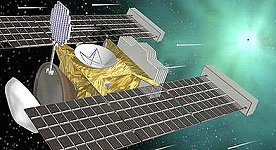
Above: NASA's Stardust spacecraft will be one of many
distant missions competing for Deep Space Network time in 2003.
NASA recently announced it's upgrading the DSN to handle a surge in interplanetary
traffic. "We're getting ready for a crunch period beginning in November 2003,"
said Rich Miller, head of planning and commitments at JPL. That's when the U.S., Europe
and Japan all will have missions arriving at Mars. These include NASA's 2003 Mars Exploration Rovers, the ESA Mars Express Mission,
and the Japanese Nozomi spacecraft. At the same time Stardust
and Deep Space 1 will be encountering comets and a third comet mission named
"CONTOUR" will launch. And, of course, other ongoing missions will have
continuing communications needs.
"[These new] missions all happen to lie in the same part of the sky," said
Statman, who described the area where the spacecraft will cluster as a slice of the sky
with Mars in the middle. "We need to track them but we don't have enough
antennas."
Madrid will receive a new 34-meter antenna that will increase available
spacecraft-tracking time by about 105 hours per week when Mars is in view. The Madrid
complex's current capacity is 315 hours.
"The tracking capacity is proportional to the number of antennas at each
location," said Statman. "At the moment, Madrid is the most crucial site for an
upgrade simply because we need more tracking time there."
Goldstone already supports as many as 420 hours per week of deep space communication, a
figure that will balloon to 525 hours when an existing antenna comes online in 2003.
"Both the Japanese and the Europeans have tracking antennas in Australia," says
Statman, so they can help with the communications load at that longitude.
As part of the upgrade, older hardware and software systems will be phased out and
replaced with ones that are more reliable and, in some cases, automated. Also, Madrid and
Canberra will receive processing equipment that will allow operators to combine signals
from multiple on-site antennas, increasing their sensitivity to distant transmissions.
Goldstone can already do that.
Every bit of extra sensitivity is welcome, says Statman. The total signal power
arriving at a network antenna from a spacecraft transmitting from the outer solar system
is 20 million times weaker than the power level from a modern digital watch battery!
Teasing out faint signals from space probes isn't all the DSN does -- it's
a powerful scientific instrument in its own right. The Goldstone 70-meter antenna, for
example, doubles as a powerful solar system radar. It captures radar images of planets and
passing asteroids, searches for water on the Moon, and helps pick landing sites on Mars.
Together, the three DSN facilities along with other antennas around the world form a
powerful Very Long Baseline Interferometer that can peer into the hearts of quasars,
measure Earth's continental drift -- even test general relativity.
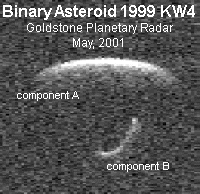
Above: Astronomers used the Goldstone radar to image
near-Earth asteroid 1999 KW4 when it passed by Earth last month. They discovered the space
rock was a binary!
A Supernova Sheds Light on Dark Energy
A discovery by astronomers using the Hubble Space Telescope supports the notion that the
Universe is filled with a mysterious form of energy pushing galaxies apart at an
ever-increasing rate.
April 3, 2001 -- NASA's Hubble Space Telescope has spotted a burst of
light from an exploding
star located much farther from Earth than any previously seen - a supernova blast in the
early Universe that is casting light on a mystery of truly cosmic scale. This stellar
explosion is extraordinary not only because of its tremendous distance -- 10 billion
light-years from our planet -- but also because it greatly bolsters the case for the
existence of a mysterious form of "dark energy" pervading the
cosmos. The concept of dark energy, which shoves galaxies away from each other at an ever-
increasing speed, was first proposed, then discarded, by Albert Einstein early in the last
century.

Above: This image from the Hubble Space Telescope
shows the supernova that is providing new evidence for the theory that a mysterious form
of "dark energy" is causing the expansion of the universe to accelerate.
The Hubble discovery also reinforces the startling idea that the universe only recently
began speeding up -- it offers the first tantalizing observational evidence that gravity
began slowing down the expansion of the universe after the Big Bang, and only later did
the repulsive force of dark energy win out over gravity's grip.
The team of astronomers, led by Adam Riess of the Space Telescope Science Institute
(STScI), made the discovery by analyzing hundreds of images taken by Hubble to study how
galaxies formed.
"This supernova appears to be one of a special class of explosions that allows
astronomers to understand how the universe's expansion has changed over time, much as the
way a parent follows
a child's growth spurts by marking a doorway," said Riess. "It shows us the
universe is behaving like a driver who slows down approaching a red stoplight and then
hits the accelerator when the light turns green." The record-breaking supernova
appears relatively bright, a consequence of the Universe slowing down in the past (when
the supernova exploded) and accelerating only recently. "Long ago, when the light
left this distant supernova, the universe appears to have been slowing down due to the
mutual tug of all the mass in the universe," explained Riess. "Billions of years
later, when the light left more recent supernovas, the universe had begun accelerating,
stretching the expanse between
galaxies and making objects in them appear dimmer."

Above and Below:
Astronomers know the universe is expanding because of the "red shift" seen in
the light from distant galaxies. Due to the Doppler Effect, light waves are compressed
when a light source is moving toward you and stretched when it's moving away. This happens
to sound waves too, which is why the pitch of a police car's siren drops as the car passes
you. With light, however, frequency equates with color, not pitch. Higher frequencies look
bluer and lower frequencies look redder. So the "red shift" in the light from
the galaxies around ours means those galaxies are moving away from us. How could all the
galaxies be moving away from us? Only if the universe itself is expanding, as demonstrated
by the balloon below.

"Hubble's ability to find titanic stellar explosions at these extreme
distances is what it takes to confirm this theory that the universe must have been slowing
down before it switched into high gear," said Dr. Anne Kinney, Director of NASA's
Origins program at NASA Headquarters, Washington, DC. "Later
this year astronauts will install a new camera on Hubble that will give us 10 times better
resolution than the current camera, which will give us even better capability to find
answers to grand cosmic questions like this."
Observations of several distant supernovae by two teams of astronomers in 1998 led to the
theory that the universe got the "green light" to accelerate when it was half
its present age. Astronomers say the new Hubble findings rule out other explanations.
Nearly a century ago, Einstein's Law of General Relativity concluded the universe must
collapse under the relentless pull of gravity. However, like many scientists of his time,
he assumed the universe to be static and unchanging. To make his equations fit those
assumptions, Einstein added something he called the "cosmological
constant" whose gravity is repulsive, though he had no idea if it was real.

Above: Albert Einstein revamped
humanity's understanding of the universe in several fundamental ways. Special Relativity
overhauled our notions of space and time, and General Relativity modified those ideas to
include an explanation of the hitherto mysterious force of gravity.
Now it appears his conjecture that the universe is pervaded by an expansive force called
the "cosmological constant" was also correct. Shortly afterwards, astronomer
Edwin Hubble made the celebrated discovery that the universe was expanding. He assumed
that the universe must be slowing down under gravity and might even come to a halt,
leading Einstein later to say that his cosmological constant was the biggest blunder of
his career. Now it appears Einstein was on the right track after all. The source of the
repulsive gravity may be something akin to Einstein's cosmological constant -- referred to
as the energy of the "quantum vacuum," a subatomic netherworld pervading space
-- or it may be something entirely new and unexpected. "While we don't know what dark
energy is we are certain that understanding it will provide crucial clues in the quest to
unify the forces and particles in the universe, and that the route to this understanding
involves telescopes, not accelerators," said astrophysicist Michael Turner of the
University of Chicago.
It's Not Over Yet!
Following one of the softest planetary landings in history, ground
controllers have decided to extend NEAR Shoemaker's mission a little longer. Scientists
hope to gather unique data from the very surface of asteroid Eros.
February 14, 2001 -- One year after NASA's NEAR Shoemaker spacecraft went into
orbit around asteroid 433 Eros, and two days after it actually landed on the space rock,
mission planners say they aren't ready to turn off the spacecraft just yet.
The mission will be extended for up to10 days to gather data from a scientific
instrument that could provide unprecedented information about the surface and subsurface
composition of the asteroid.
Near Shoemaker's historic soft landing on Eros has turned out to be a mission planner's
dream. "We put the first priority on getting high-resolution images of the surface
and the second on putting the spacecraft down safely - and we got both," says NEAR
Mission Director Robert Farquhar of the Johns Hopkins University Applied Physics
Laboratory, which manages the Near Earth Asteroid Rendezvous (NEAR) mission for NASA.
"This could not have worked out better," he said.
Two days after a
set of maneuvers brought it to the surface of Eros, NEAR Shoemaker is still communicating
with the team at the Applied Physics Lab. The spacecraft gently touched down just after
3:01 p.m. EST on Monday, February 12th, ending a full year in orbit around the large space
rock.
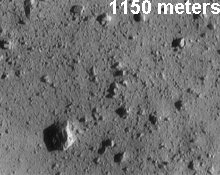
Above: These images were captured by
NEAR Shoemaker as it descended to the
surface of Eros on February 12, 2001.
Mission operators say the touchdown speed of less than 4 miles per hour (between 1.5
and 1.8 meters per second) may have been one of the slowest planetary landings in history.
They also have a better picture of what happened in the moments after the landing: What
they originally thought was the spacecraft bouncing may have been little more than a short
hop or "jiggle" on the surface; the thrusters were still firing when the craft
hit the surface, but cut off on impact. NEAR Shoemaker came down only about 650 feet (200
meters) from the projected landing site.
"It essentially confirmed that all the mathematical models we proposed for a
controlled descent would work," says Bobby Williams, NEAR navigation team leader at
NASA's Jet Propulsion Laboratory. "You never know if they'll work until you test
them, and this was like our laboratory. The spacecraft did what we expected it to do, and
everyone's real happy about that."
NEAR Shoemaker snapped 69 detailed pictures during the final
three miles (five kilometers) of its descent, the highest resolution images ever obtained
of an asteroid. The camera delivered clear pictures from as close as 394 feet (120 meters)
showing features as small as one centimeter across. The images also included several
things that piqued the curiosity of NEAR scientists, such as fractured boulders, a
football-field sized crater filled with dust, and a mysterious area where the surface
appears to have collapsed.
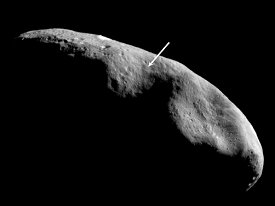
The location of NEAR Shoemaker's landing site as viewed from an orbital
altitude of 200 kilometers (124 miles). The landing site (at the tip of the arrow) is
near the boundary of two distinctly different regions: To the south and east (above
and to the left) lies older, cratered terrain, while to the north (down) is the saddle-
shaped feature Himeros, whose lesser density of superposed craters indicates
relatively recent resurfacing by geologic processes.
These spectacular images have started to answer the many questions we had
about Eros," says Joe Veverka, NEAR's imaging team leader from Cornell University,
N.Y., "but they also revealed new mysteries that we will explore for years to
come."
Yesterday, the NEAR mission operations team decided against
another engine firing that could have lifted the space probe off the asteroid's surface
again.
Funding for the mission's extension will come from the NEAR project.
February 3, 2000 -- In J.R.R. Tolkien's well-known fantasy The Hobbit,
the diminutive inhabitants of the Shire loved to smoke pipe-weed and blow intricate rings
to delight their visitors. Only the powerful wizard Gandalf could best a Hobbit in that
difficult art.
Here in the real world, the best way to enjoy an enchanting tobacco-free smoke ring may
surprise you. Simply tune in to the Solar and Heliospheric Observatory (SOHO), an
Earth-orbiting observatory with an eye on the biggest puffer in the solar system -- the
Sun.
Beginning on January 28, 2000, SOHO recorded a series of dramatic solar coronal mass
ejections (CMEs) as the Sun belched billions of tons of hot gas into interplanetary space.
One of them, sighted on January 31, displayed swirling loops reminiscent of Bilbo
Baggins's most elegant smoke rings.
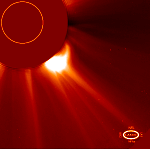
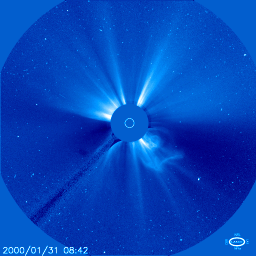
These coronagraph images captured by SOHO on January 31, 2000, show a beautiful
coronal mass ejection erupting from the southwest limb of the Sun. The red-colored
animation, which targets the Sun's inner corona from 1.1 to 3 solar radii, spans a six
hour period beginning at 0154 UT. The swirls inside the CME are about 30 times bigger than
Earth! The blue image displays the outer corona from 1.5 to 30 solar radii. It shows the
CME at 1154 UT, about 10 hours after the eruption began.
Coronal mass ejections can carry up to 10 billion tons of plasma traveling at speeds as
high as 2000 km/s. When they collide directly with Earth they can excite geomagnetic
storms, which have been linked to satellite communication failures. In extreme cases, such
storms can induce electric currents in the Earth and oceans that can interfere with or
even damage electric power transmission equipment.
Fortunately, none of the latest CMEs were headed in our direction. Earth-directed mass
ejections produce what astronomers call "Halo events." As they loom
larger and larger they appear to envelope the Sun itself.
The recent batch of CMEs -- mostly seen in profile -- look very much like expanding
tangled loops. While there is some visual similarity to smoke rings, the physics of a CME
is different. Common down-to-Earth smoke rings are spinning
doughnut-shaped bundles of unmagnetized, neutral gas. They have lower pressure on the
inside than the outside, and can travel considerable distances as they expand and
dissipate into the surrounding air. On the other hand, gas inside a coronal mass ejection
is completely ionized and permeated by strong magnetic fields. The magnetic forces
dominate the movements and structure of the plasma. Most of the loops seen in a CME are
hot glowing gas trapped inside curved magnetic fields.
If not for the coronagraphs on the Solar and Heliospheric Observatory, many CMEs would
never be noticed. At present, SOHO is only spacecraft that monitors the Sun's outer corona
nearly around the clock. Two others, TRACE
and Yohkoh, keep an eye on the inner
corona, but CMEs are harder to spot there. Space weather forecasters rely on SOHO for
early warnings of many Earth-directed solar eruptions, a service that is increasingly
important as we approach the solar maximum in mid-2000.
"During solar maximum we often have more than one coronal mass ejection every
day," explains David Hathaway, a solar physicist at the NASA Marshall Space Flight
Center. "The basic cause of CMEs is fairly well understood. Like solar flares, they occur
whenever there's a rapid, large-scale change in the sun's magnetic field. Solar flares and
CMEs often occur together, as they did this weekend, but not necessarily because the flare
triggers the CME or vice versa. One can happen without the other and frequently during
solar maximum we see CMEs without an associated flare."
The CME on January 28, pictured here, was associated with a weak C1.1-class solar flare
near sunspot group 8848. That active region had 3 tiny sunspots and a relatively
uncomplicated beta-type
magnetic field structure. C-class flares are ones that register between 10-6
and 10-5 Watts per square meter in the 1 to 8 Angstrom X-ray band on NOAA's
Earth-orbiting GOES 8 satellite. They are considered to be small compared to the much
larger M-class and
X-class flares that can erupt from active regions with more complicated magnetic
fields.
The "Bilbo Baggins" CME on January 31 was located near a larger sunspot group
(8841) composed of 8 tiny spots. That active region also manifested a beta-type field, but
the NOAA Space Environment Center did not report an associated solar flare. The January 31
CME is classified as a "disappearing solar filament" (DSF) type, which means
that it occurred at about the same time that a filament rose off the Sun's surface.
Filaments are dense clouds of material suspended above the surface of the Sun by loops of
magnetic field. They can remain in a quiescent state for weeks. As the magnetic loops that
support them slowly change, they can erupt and rise off of the Sun in just a few minutes.
A filament viewed in profile over the limb of the sun is called a prominence.
"Although we understand the basics of why CMEs happen," continued Hathaway,
"the details are still unclear. What makes the fields unstable? How rapid is the
onset of the explosion? What's the detailed relationship between flares and filaments and
CMEs? All these questions are being actively researched, and we still can't predict CME
events with any reasonable degree of accuracy."
With solar maximum slated for mid-2000 solar observers should have plenty of opportunity
to study solar flares and CMEs, and to hone their space weather forecasting skills.
Orion
Nebula: The Jewel in the Sword
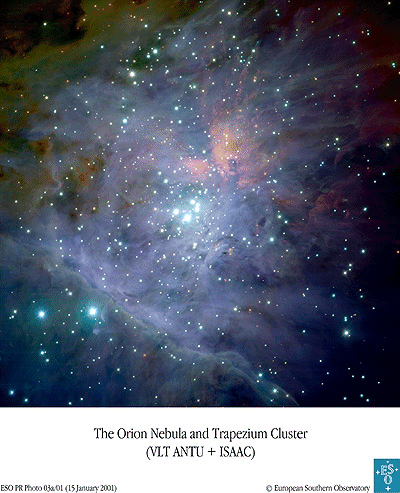
This is a color composite mosaic image of the central part of the Orion Nebula,
based on 81 images obtained with the infrared multi-mode ISAAC instrument
on the ESO Very Large Telescope (VLT) at the Paranal Observatory. The famous
Trapezium stars are seen near the centre and the photo also shows the associated
cluster of about one thousand stars, about a million years old.
Chandra
Evidence:
Boundaries Around Black Holes

Top: Gas from the companion star is drawn by gravity onto the black hole in a
swirling pattern.
As the gas nears the event horizon,
a strong gravitational redshift makes it appear redder and
dimmer. When the gas finally crosses the
event horizon, it disappears from view. Because of
this, the region within the event horizon
appears black.
Bottom: As above, gas from the companion star flows down onto the collapsed
star--in this
case a neutron star instead of a black
hole. As the gas approaches the neutron star, a similar
gravitational redshift makes the gas
appear redder and dimmer. However, when the gas strikes
the solid surface of the neutron star, it
glows brightly.
Hubble Confirms Existence of Massive Black
Hole at Heart of Active Galaxy
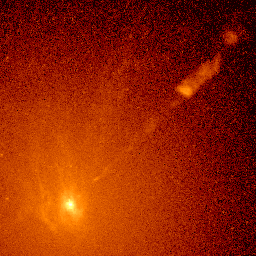
A NASA Hubble Space Telescope image of a spiral-shaped disk of hot gas in
the core of active
galaxy M87. HST measurements show the disk is rotating so rapidly it contains a massive
black
hole at its hub.
A black hole is an object that is so massive yet compact nothing can
escape its gravitational pull,
not even light. The object at the center of M87 fits that description. It weights as much
as three
billion suns, but is concentrated into a space no larger than our solar system.
Now that astronomers have seen the signature of the tremendous
gravitational field at the center
of M87, it is clear that the region contains only a fraction of the number of stars that
would be
necessary to create such a powerful attraction.
The giant elliptical galaxy M87 is located 50 million light-years away in
the constellation Virgo.
Earlier observations suggested the black hole was present, but were not decisive. A
brilliant jet
of high- speed electrons that emits from the nucleus (diagonal line across image) is
believed to
be produced by the black hole "engine."
The image was taken with HST's Wide Field Planetary Camera 2
The Solar Wind at Mars
The solar wind has slowly eroded the Martian atmosphere
for billions of years -- transforming the planet into a barren desert.
January 31, 2001 -- If it were possible to magically transport a cup of water
from Earth to the surface of Mars, the liquid would instantly vaporize. Mars's atmosphere
is so vacuous (it's less than 1% as dense as Earth's) that liquid water simply can't exist
for very long on the Red Planet.
That's a puzzle to planetary scientists, because Mars's surface is littered with signs
of liquid water. Dried up valley networks, sedimentary deposits, and chaotic flood plains
hint that billions of years ago Martian water flowed freely and that the atmosphere there
must have been substantially thicker than it is now. But where did it all that Martian air
go?
New evidence from NASA's Mars Global Surveyor (MGS) spacecraft supports a long-held
suspicion that much of the Red Planet's atmosphere was simply blown away -- by the solar
wind.
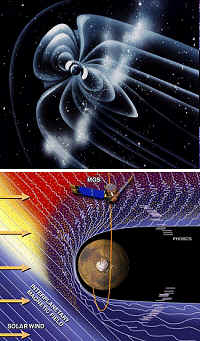
Above: Earth is shielded from the
solar wind by a magnetic bubble extending
50,000 km into space -- our planet's magneto-
sphere.
Below: Without a substantial
magnetosphere to protect it, much of Mars's
atmosphere is exposed directly to fast-moving
particles from the Sun.
The solar wind is a fast-moving part of the Sun's outer atmosphere. The solar corona,
with a temperature greater than one million degrees C, is so hot that the Sun's gravity
can't hold it down. It flows away in all directions traveling 400 to 800 km/s. Every
planet in the solar system is immersed in this gusty breeze of charged particles.
Here on Earth we're protected from the solar wind by a global magnetic field (the same
one that causes compass needles to point north). Our planet's magnetosphere, which extends far out into space, deflects solar wind ions
before they penetrate to the atmosphere below.
Mars isn't so fortunate. Lacking a planet-wide magnetic field, most of the Red Planet
is exposed to the full force of the incoming solar wind. "The Martian atmosphere
extends hundreds of kilometers above the surface where it's ionized by solar ultraviolet
radiation," says Dave Mitchell, a space scientist at the University of California at
Berkeley. "The magnetized solar wind simply picks up these ions and sweeps them
away."
"In 1989 the Soviet Phobos probe made direct measurements of the atmospheric
erosion," he continued. When the spacecraft passed through the solar wind wake behind
Mars, onboard instruments detected ions that had been stripped from Mars's atmosphere and
were flowing downstream with the solar wind. "If we extrapolate those Phobos
measurements 4 billion years backwards in time, solar wind erosion can account for most of
the planet's lost atmosphere."
"To calculate the total loss of atmosphere," he added, "we must take
into account how the Sun has changed during the past four billion years. The Sun's
ultraviolet output was larger in the past, and the solar wind was probably much stronger.
This means that solar wind erosion was likely much more effective in the past than it is
today."
Although Mars no longer has a substantial magnetosphere, scientists think it once did
and that the remnants of it still exist. In 1998 magnetometers on MGS discovered a network
of magnetic loops arrayed across Mars's southern hemisphere. Locally, the magnetic fields
arch over the surface like umbrellas, hundreds of km high. "If you were standing on
Mars in one of these areas," says Mitchell, "you would measure a magnetic field
about as strong as Earth's -- a few tenths of a gauss." Elsewhere on the planet the
magnetic field is 100 to 1000 times weaker.
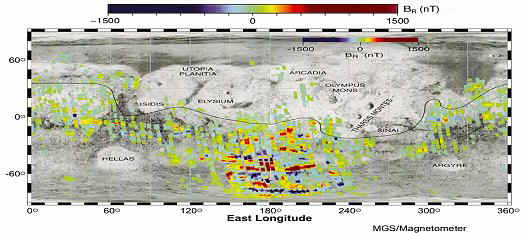
A map of the vertical (radial) component of magnetic fields poking out of the Martian
crust.
Red and blue areas are zones where stronger-than-average magnetic fields protect the
planet
from solar wind erosion.
Indeed, it appears that Mars's magnetic umbrellas act like miniature magnetospheres.
They ward off the solar wind in their vicinity and harbor pockets of gas ionized by solar
UV radiation that would otherwise be blown away.
At a recent meeting of the American Geophysical Union, Mitchell and colleagues unveiled
the first-ever global map of the Red Planet's ionosphere (the ionized part of the
atmosphere), based on data from the Mars Global Surveyor electron reflectometer. "The
ionosphere nicely traces the distribution of the surface magnetic field, and there seems
to be a 1-to-1 correspondence," noted Mitchell. Places where magnetic umbrellas
deflect the solar wind are also spots where the ionosphere is retained high above the
surface of the planet.
Mitchell cautions that beneath these magnetic umbrellas the neutral atmosphere at
Martian "sea level" isn't particularly dense -- they are not oases of air for
future colonists! Rather, the mini-magnetospheres are simply places where high-altitude
atmospheric losses are relatively low. Most of Mars is still subjected to the full force
of the solar wind. To retain a thick atmosphere, a planet-wide magnetic field would be
needed.
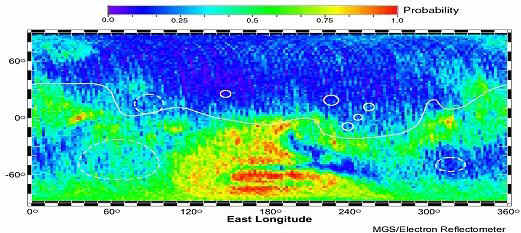
A map of the ionosphere on Mars. Colors represent the
probability that Mars Global Surveyor
will be in the ionosphere when orbiting at 400
kilometer's altitude. Blue is a low probability,
meaning the spacecraft is usually in the solar
wind and the ionosphere is below the spacecraft.
Yellow and red show where the ionosphere often
protrudes above 400 kilometers altitude.
(Credit: David Mitchell, UC Berkeley.)
Earth's global magnetic field comes from an active dynamo -- that is, circulating
currents at the planet's liquid metallic core. A similar dynamo once churned inside Mars,
but for reasons unknown it stopped working four billion years ago. The patchwork fields we
see now are remnants of that original magnetic field.
How do scientists know when the dynamo turned off? "Mars has been kind to
us," explains Mitchell. "There are two large impact basins, Hellas and Argyre,
about four billion years old that are demagnetized. If the dynamo was still operating when
those impact features formed, the crust would have re-magnetized as they cooled. The
dynamo must have stopped before then."
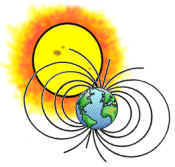
Earth also has an ionosphere maintained by solar UV, but on our world --unlike Mars-- the
ionosphere envelops the entire planet. It begins at an altitude of about 90 km and
stretches thousands of km into space. Because the ionosphere fits safely inside our
planet's much-larger magnetosphere, solar wind erosion is not a problem. That's good news
for ham radio operators who depend on the radio-reflective ionosphere for over-the-horizon
shortwave communications. Living on a magnetized planet has its advantages!
The advantages might be even bigger than amateur radio, though. Planetary magnetic
fields could be an essential ingredient for life-bearing worlds circling stars with strong
solar winds, worlds that need to retain a substantial atmosphere and liquid water. Indeed,
if the Martian dynamo hadn't shut down billions of years ago, the Red Planet might be
teeming with Martians today. Instead Mars is a frigid desert, apparently as barren of life
as it is of its long-gone magnetic personality!
|